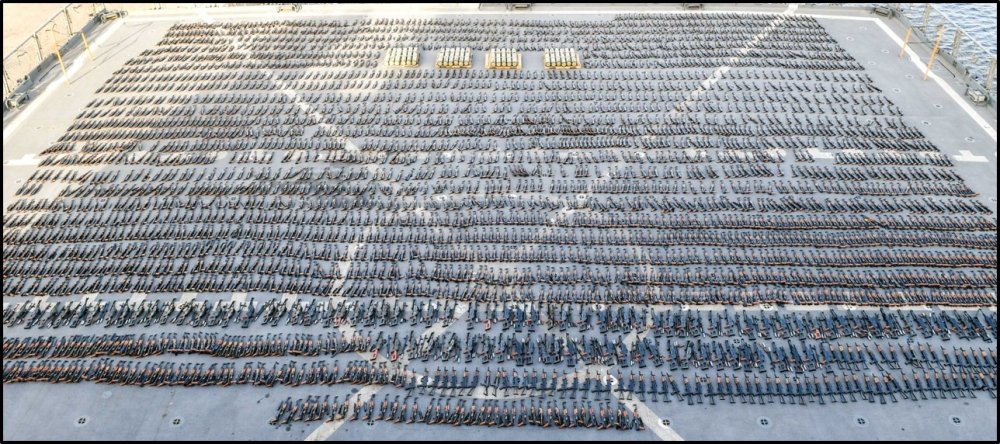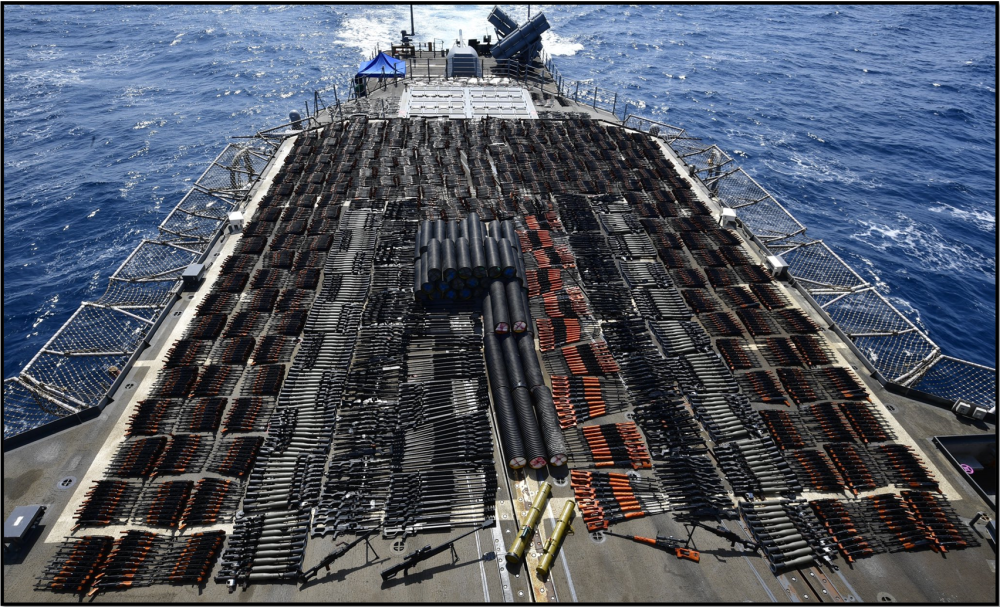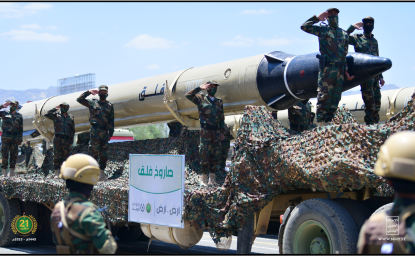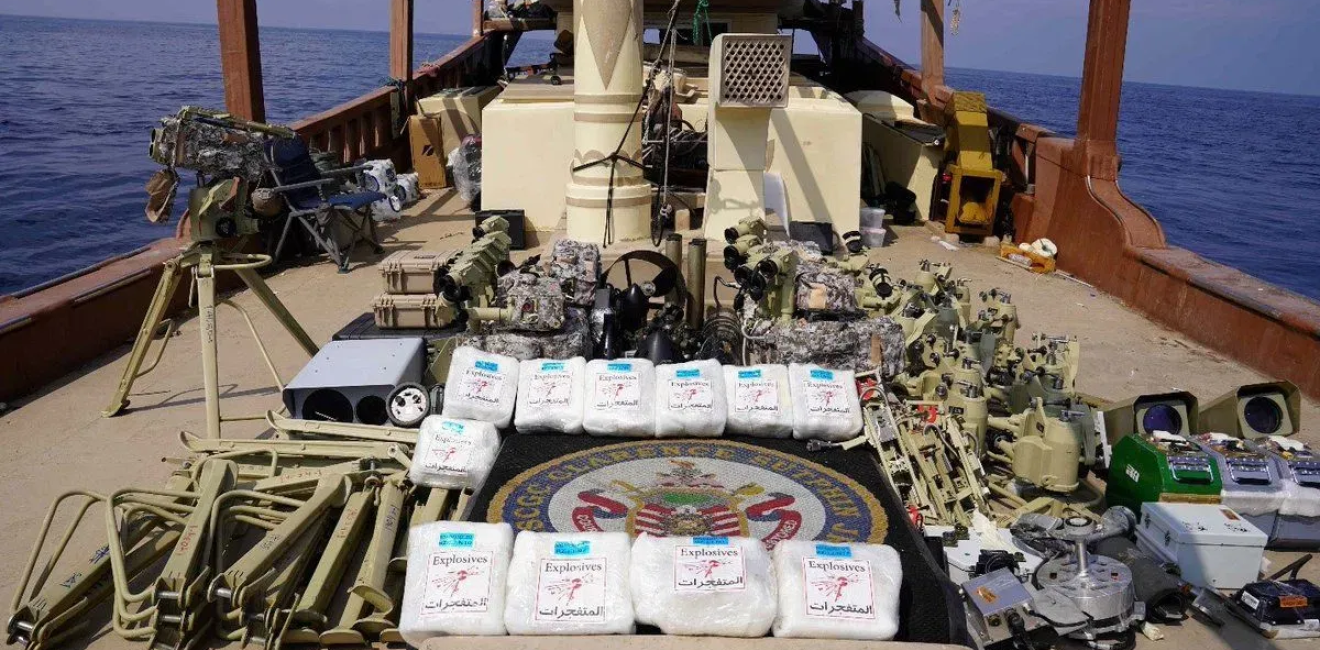Between 2015 and 2024, the United States and its allies intercepted at least 18 shipments of weapons allegedly originating from Iran and headed to Yemen. The vessels were usually unflagged dhows, wooden boats or fishing vessels. Their cargoes varied in size, and the weapons varied in lethality. Some ships carried small arms, such as machine guns and AK-47 assault rifles. Others carried anti-tank and surface-to-air missiles or components for anti-ship and land attack cruise missiles. The shipments were likely intended for the Houthi rebels, a Zaydi Shiite militia group supported by Iran. The following is a rundown of seizures, beginning with the most recent:
2024
January 28: U.S. forces from the USCGC Clarence Sutphin Jr boarded and seized a ship in the Arabian Sea transporting advanced weapons and other aid from Iran to the Houthis. The boarding team discovered ballistic missile components, explosive, unmanned underwater vehicle and unmanned surface vehicle components, military communication equipment, and anti-tank guided missile components.
January 11: U.S. Navy SEALs boarded and seized a dhow transporting weapons from Iran to the Houthis. The operation, off the coast of Somalia, marked the first seizure of Iranian weapons since the Houthis began attacking commercial ships in the Red Sea in November 2023. Seized items included propulsion, guidance, and warheads for Houthi medium-range ballistic missiles and anti-ship cruise missiles, as well as air defense-associated components.
2023
February 23: The British Navy, with U.S. support, intercepted a vessel that appeared to be sailing from Iran to Yemen. The ship was carrying anti-tank missiles and fins for ballistic missiles. “This seizure by HMS Lancaster and the permanent presence of the Royal Navy in the Gulf region supports our commitment to uphold international law and tackle activity that threatens peace and security around the world,” said British Defense Secretary Ben Wallace. “This is the seventh illegal weapon or drug interdiction in the last three months and yet another example of Iran’s increasing malign maritime activity across the region,” said the commander of the U.S. 5th Fleet, Vice Admiral Brad Cooper.
January 15: French Special Forces, in coordination with U.S. forces, intercepted a ship of the Yemeni coast that was smuggling more than 3,000 assault rifles, a half million rounds of ammunition and 20 antitank guided missiles. “CENTCOM and partner naval forces regularly conduct regional maritime security operations,” a CENTCOM statement said. “Over the past two months alone, we and our partners have prevented more than 5,000 weapons and 1.6 million rounds of ammunition from reaching Yemen,” said Commander Tim Hawkins, a spokesman for the U.S. Fifth Fleet.

January 6: Three U.S. ships, the USS Chinook, USS Monsoon, and the USS The Sullivans intercepted a dhow in the Gulf of Oman smuggling over 2,000 AK-47 assault rifles. The dhow was transiting international waters from Iran to Yemen. “The illegal flow of weapons from Iran through international waterways has a destabilizing effect on the region,” said General Michael Kurilla, the head of U.S. Central Command. “We are committed to the security and stability of the region and the enforcement of international law.” Vice Admiral Brad Cooper said that the shipment was “part of a continued pattern of destabilizing activity from Iran.”
2022
November 8: Two U.S. ships, the USCGC John Scheuerman and USS The Sullivans, interdicted a dhow carrying 70 tons of ammonium perchlorate, a compound commonly used to make rocket and missile fuel as well as explosives. The dhow was on a route used to traffic weapons from Iran to the Houthis in Yemen. “This was a massive amount of explosive material, enough to fuel more than a dozen medium-range ballistic missiles depending on the size,” said Vice Admiral Brad Cooper, commander of U.S. Naval Forces Central Command, U.S. 5th Fleet and Combined Maritime Forces. The ammonium perchlorate was hidden under 100 tons of urea, a fertilizer that can also be used to manufacture explosive. The four crewmembers, Yemeni nationals, were transferred to Yemen on November 15.
July 8: Britain and the United States confiscated Iranian weapons bound for Yemen during naval military operations on January 28 and February 25. The equipment included surface-to-air missiles and cruise-missile rocket engines that were on speedboats in the Gulf of Oman. “This is the first time a British Naval warship has interdicted a vessel carrying such sophisticated weapons from Iran,” the Royal Navy said in a statement on July 7. A U.S. Navy destroyer supported Royal Navy forces in the second seizure in February. “This action demonstrates that we will not allow irresponsible and aggressive acts by Iran to go unchecked on land, sea, and air,” U.S. Central Command said in a statement.
January 18: Guided-missile destroyer USS Cole and patrol coastal ship USS Chinook intercepted a stateless vessel transiting from Iran and seized 40 tons of urea fertilizer, a compound often used to manufacture explosives. The same ship had previously been seized off the coast of Somalia and found to be carrying weapons suspected to have come from Iran and destined for Houthi rebels in Yemen.
2021
December 20: The USS Tempest and USS Typhoon interdicted a stateless fishing vessel in the northern Arabian Sea with a cache of illicit weapons, including 1,400 AK-47 assault rifles and 226,600 rounds of ammunition. The ship was on a route historically used to illegally smuggle weapons to the Houthis in Yemen. “The smuggling of arms from Iran to the Houthis represents a flagrant violation of the UN targeted arms embargo and is yet another example of how malign Iranian activity is prolonging the war in Yemen,” State Department Spokesperson Ned Price said. U.S. Navy personnel removed the weapons and ammunition from the ship and planned to return the crew, including five Yemeni nationals, to Yemen.
May 6 - 7: The USS Monterey interdicted an unflagged dhow in the northern Arabian Sea with a large cache of illicit weapons, including dozens of Russian anti-tank missiles, thousands of Chinese-made assault rifles, and hundreds of machine guns, sniper rifles and rocket-propelled grenades. Navy photos showed the weaponry laid out on the deck of the Monterey. The source and destination of the weapons were “under investigation,” U.S. Fifth Fleet based in Bahrain said in a statement. U.S. naval and coast guard personnel removed the cargo from the dhow and questioned the crew before releasing them.

2020
June 28: The U.S. Navy and partner forces interdicted a boat off the coast of Yemen. The vessel was carrying “200 RPGs, more than 1,700 AK rifles, 21 surface-to-air and land-attack missiles, several anti-tank missiles, and other advanced weapons and missiles,” Secretary of State Mike Pompeo told reporters on July 8, 2020. “Iran is not abiding by the U.N. arms embargo restrictions that are due to expire in less than four months now.”
Feb. 9: The USS Normandy interdicted the Al Qanas 1, an unflagged dhow in the Arabian Sea manned by Yemeni nationals. The vessel was carrying 150 anti-tank missiles, three surface-to-air missiles, night vision scopes and drone components, the Justice Department reported. U.S. naval personnel interrogated the dhow’s crew before handing them over to the Yemeni Coast Guard. The weapons were “destined for the Houthi rebels,” according to the Pentagon. “There’s not a plausible explanation for how these weapons got on the dhow without the sanction of the Iranian government,” said Captain Bill Urban, the CENTCOM spokesperson. The Justice Department later connected the Al Qanas 1 to the Qods Force. A U.N. panel of experts also concluded that the anti-tank missiles were most likely "manufactured in the Islamic Republic of Iran."
2019
Nov. 25: The USS Forrest Sherman interdicted the Al Raheeb, an unflagged wooden dhow crewed by Yemeni nationals in the northern Arabia Sea. The boat was carrying 21 anti-tank missiles, five surface-to-air missiles, components for land-attack and anti-ship cruise missiles, thermal optical sights, blasting caps and drone components, according to a Justice Department filing. The missiles were “the most sophisticated weapons seized by the U.S. Navy to date during the Yemen conflict,” U.S. Special Representative for Iran Brian Hook said on December 5, 2019. The Justice Department later connected the Al Raheeb to the Qods Force. A U.N. panel of experts concluded that the Al Raheeb carried “Iranian” anti-tank missiles.
2016
Mar. 28: The USS Sirocco interdicted a dhow in the Arabian Sea headed for Yemen. The vessel was carrying “1,500 AK-47s, 200 RPG launchers and 21 .50 caliber machine guns,” the U.S. Navy said in a statement. The weapons were taken into U.S. custody, while the crew were permitted to depart. The U.S. Navy said that the weapons “originated in Iran” and were “likely bound for Houthi insurgents in Yemen.”
Mar. 20: The FS Provence, a French destroyer, interdicted a dhow in the northern Indian Ocean. The dhow was carrying “several hundred AK47 assault rifles, machine guns and anti-tank weapons,” according to the Combined Maritime Forces (CMF), a U.S.-led coalition of 34 nations that operates in the Rea Sea, Gulf of Aden and Gulf of Oman. The taskforce initially said that the weapons were destined for Somalia, but the U.S. Navy later assessed that the weapons originated from Iran and were destined for Yemen.
Feb. 28: The HMAS Darwin, an Australian warship, interdicted an unflagged fishing vessel more than 170 miles off the coast of Oman. The crew “searched the vessel and discovered 1989 AK-47 assault rifles, 100 rocket propelled grenade launchers, 49 PKM general purpose machine guns, 39 PKM spare barrels and 20 60mm mortar tubes,” the CMF reported. A CMF taskforce initially said that the fishing vessel was headed toward Somalia, but the U.S. Navy later assessed that the weapons originated from Iran and destined for Yemen.
2015
Sept. 30: The Saudi-led coalition in Yemen interdicted an Iranian fishing boat in the Arabian Sea about 150 miles off the coast of Oman. The vessel was carrying 18 anti-tank missiles, 54 anti-tank shells, 15 shell battery kits, four firing guidance systems and five binocular batteries “destined to the Houthi militias” in Yemen, the coalition reported. The Iranian crew claimed that the vessel was bound for Somalia.
Related Material:

The Islamists
Learn more about Hamas and how it relates to similarly aligned organizations throughout the region. Read more

Explore More
Browse Insights & Analysis
Designating Houthi Militia as FTO: A Matter of US Security and Global Stability

In Yemen, Russia Drops Political Diplomacy to Support Houthi Militants


